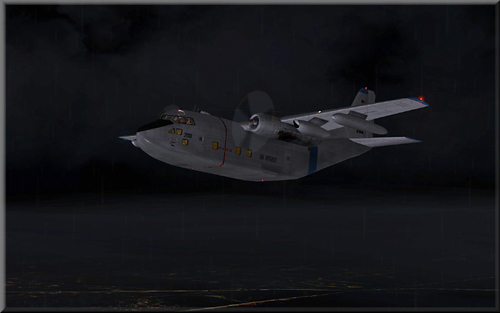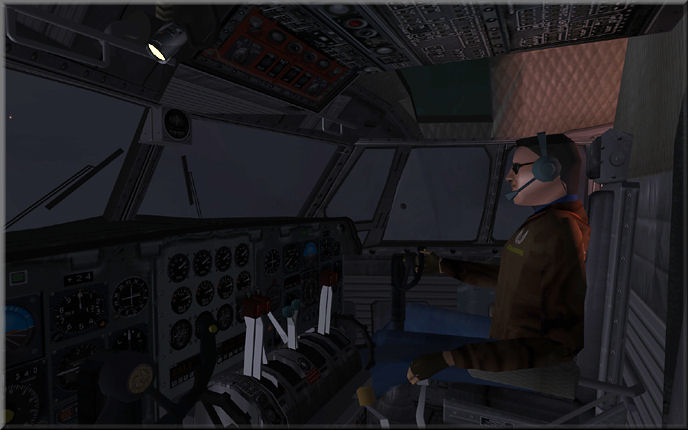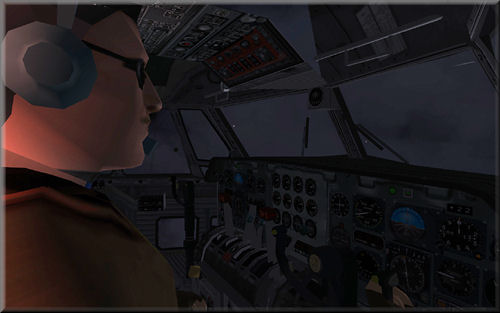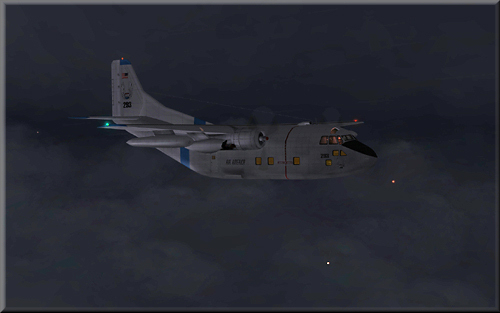|
Chapter 2
"Cruise"
“Flaps zero.”
“Flaps zero.” Joe’s hand moves and the hydraulic noises
begin, peak, then diminish slowly as the last notch of
the boards comes all the way in. It takes about 12
seconds. Now the noise stops and both the aircraft nose
and the airspeed needle have risen somewhat.
“Shut down the jets”
“Shut down jets”, replies Joe, discarding my superfluous
“the”.
The Provider K-model has a pair of turbojets outboard of
the recips. They’re only used for take-off, but they’re
a blessing when we’re heavy, making short runways seem
longer – and safer. I think of them as a quarter of a
B-52 acting as tugboat for us. Once we’re out of the
harbor, we don’t need the tug any more.
The high pitched whine of the jets that’s just audible
amid the noise of the big radial engines tapers off
quickly as Joe pulls the condition levers back together,
to the flight idle detent. He pauses for 30 seconds to
let them spool down and cool down a bit, then brings the
levers all the way back to the cutoff position. The nose
comes back down some as the jets considerable thrust
vanishes. There isn’t much reduction in sound however,
as the Pratt & Whitneys bellow their climb-out song at
28 inches of manifold pressure. That’s de-rated quite a
bit from their Air Force days. 140 octane gasoline just
isn’t an option any more. If we were to run the boost
any higher on 100LL for any extended time detonation
would likely blow the jugs right off the crankcase.
Still, even at this power setting they’re noisy, despite
the headsets. I love their sound more than almost any
other on Earth. I’ve even been known to slide the left
headphone cup off my ear so I can enjoy it unattenuated,
but not tonight. The doc is close to convincing me
that’s not a good idea any more, and probably never was.
Still, life is good.
“Gainesville approach, Boxwings Freight Flight 201,
climbing through one five hundred for twelve thousand”,
I hear in my head phones. It’s Joe calling on our
departure frequency. Ocala has no tower, so the
procedure is to take off and contact our departure
controller in Gainesville on the designated frequency
once airborne. Gainesville is 40 or so miles north, more
or less along our route of flight tonight. We’ll be in
his area for a while before being handed off to
Jacksonville Center and points north.
“Boxwings 201, Gainesville approach; roger; radar
contact; climb and maintain one two thousand; altimeter
is two niner niner seven.” He doesn’t sound like an
auctioneer tonight. Traffic must be light.

Passing through two thousand feet I begin to pull the
mixtures back a little, starting the leaning process.
That won’t be complete until we’re level at 12,000 and
stabilized at our normal cruise speed of 168 knots. I’m
careful about leaning. We need the power, so can’t leave
them full rich all the way up, but too much of a good
thing is, well, too much of a good thing. Too lean too
soon and the engines will suffer, perhaps even fail if
I’m too ham-handed with this. It’s the thing I pay the
most attention to in the climb, even though there are
about five-hundred or so other things that need some
watching too.
The oil pressure, and the oil, cylinder head and exhaust
gas temps are in the green; I’m watching the latter two
closely as I lean the mixtures another tad. The cowl
flaps are only half-open now. The autopilot is engaged;
we’re tracking an outbound radial from OCF at Ocala,
making 800 fpm at 130 knots. The autopilot is using
almost all the nose-up trim at this weight, speed and
rate of climb, optimal in my book. We’re wallowing along
nose high with this load, but that’s what the wing needs
to support all that cargo back there, and all this fuel
and aluminum, and to still produce enough lift to climb.
The longitudinal CG had ciphered out right in the middle
of the range. It will shift forward slightly during the
night as we burn off fuel though. We were a handful of
pounds under 51,900 at lift off; legal…just. Orville and
Wilbur would be amazed – and proud, I think.
I twist my behind back and forth a little to settle more
comfortably into the designed-to-be-uncomfortable seat
as the tension of takeoff drains away. I continue to
monitor the climb. There isn’t much to do really, except
to bump the mixture levers aft every half-minute or so,
but there’s much that bears watching. Joe’s got the
radios covered; my brain gives that a tiny sliver of
attention, almost sub-conscious. It’s necessary that I
keep my head in the ATC and navigation game, but Joe
will do most of it. He’s changing to the preset
frequency on the Nav 2 radio now and I hear the Morse ID
of the next VOR in the headset for a moment. The engine
instruments are looking good, the flight instruments
show the autopilot flying better than I could and it’s
taking us where we want to go. That’s up, in this case,
and north on the 348 radial. The DME steadily clicks off
the miles, though not too quickly at this speed. The
fuel gauges show about what I expect, but we’ll get a
more precise read of that when we’re at cruise.
We’re flying IFR, of course, so the guy on the ground
staring at the radar scope has the primary
responsibility for keeping us away from other aluminum
objects and them from us. A minute or two ago I noted
that the loom of our lights in the overcast ceased as we
passed through 3,200 feet, indicating we were in the
clear. Now I look out my side windows for just a few
seconds. There’s not much to see, though I can discern
that we are above the cloud deck and there are stars,
but no moon. The overcast below is near solid, nine
tenths at least. I don’t see any other aircraft lights,
and don’t expect to see many tonight except in the
vicinity of Atlanta. None the less it always behooves
one to remember that we’re not entirely alone up here.
Radar and air traffic controllers are good, but not
infallible. I look when I can. At this attitude there’s
not much view ahead and we’re not really going where the
forward windows are pointed anyway, but lower. We’re not
likely to see anyone in that direction unless he’s
descending into us. I direct most of the
look-out-the-windows part of my attention to the side
windows during the climb. If there’s a problem, that’s
where it will appear. I know without looking that Joe is
doing the same on the other side.
Our route tonight will take us through the Atlanta area,
literally right over the busiest airport in the US.
We’ll be level at 12,000 long before that, well out of
the approach traffic. Even at this time of night though,
there will be plenty of other aircraft nearby. Most will
be below us but inevitably nearly every one of them will
have to descend or ascend through our plebian altitude
on their way to or from the patrician flight levels at
18,000 ft. and yonder. It’s still fairly early evening
and KATL has plenty of scheduled air carrier arrivals
and departures until 10:00 or so. It tapers off a lot
after that, but not to zero, and as the airline traffic
dwindles, the air cargo flights increase. It’s a lot
like I-75, but in three dimensions. Both the airspace
and the airwaves are likely to be busy.
The timing is good. We’ll be level at cruise soon enough
for me to enjoy a leisurely cup of coffee, maybe two,
before we begin to get into the Atlanta traffic. That’s
very good. I freely admit to being an unreformed, make
that un-reformable, caffeine addict. It’s not a matter
of staying awake – I managed a couple of hours sleep
this afternoon and won’t be getting drowsy. It’s just
feeding a comfort thing, and will help me be comfortably
alert while transiting Atlanta’s sphere of influence. I
don’t want to be juggling a coffee cup there, so am
thankful for a quiet hour between ToC and Atlanta.
Here we are, coming up on 12,000, nose is coming down,
airspeed’s coming up slowly, slowly, but nicely; now
back a little on the throttles as the speed increases.
Back some with the prop levers, slowing them to a less
fuel-thirsty 1,850 RPM. Keep an eye on the manifold
pressures as the props begin to take a deeper bite of
the cold air. Close the cowl flaps the rest of the way.
Nudge the throttles back some more as we come up on 160,
165, 167….168 knots. Right there! That’s nice. Manifold
pressures look good at 21 inches; now adjust the
mixtures one more time. CHTs and EGTs are good; we’re on
the roof and cruising! Oil pressures remain rock solid,
the oil temps are still high green and will come down
just a bit after throttling back from the hard work of
the climb. The P & Ws are more muted now, but still
loud. The vibration no longer hammers our spines, just
rattles things a bit. Everything looks good, everything
sounds good, everything feels good. Out of the corner of
my eye I see Joe logging a reading from the fuel
totalizer, and ask what he’s showing.

“Fifty-one hundred; five twenty a side.” All right! We
have over five thousand pounds left and each engine is
using 520 pounds an hour. We’re right on the numbers. We
can cruise for almost five hours at this power setting;
more if things begin to look tight and we throttle back.
Life is good.
C-123s don’t normally have a fuel totalizer. We spent
more money than I care to think about having one put in.
The device with its digital readout and controls had to
go on the co-pilot’s side of the panel where there was a
little more unused real estate available. Cargo flights
tend to be loaded heavy, and the trade-off between fuel
and cargo a matter of critical attention for nearly
every flight. Even when we’re not heavy there isn’t a
lot of money to be made ferrying fuel. Sometimes we cut
it pretty thin. Tonight was easy. We had a cargo that
could be divided, with some going along and some left
behind. Other times, that luxury may not be available.
If the payload is a vehicle, for instance, leaving an
eighth of it behind, even if we could figure out how,
isn’t going to make the customer want to seek us out for
future business. That’s not to say we don’t stay legal,
we do – always. But the required fuel reserve for an
alternate airport plus 45 minutes can be pretty tight
when the wind and the weather are against you. We like
to be well on the plus side of that, but it’s not always
possible. The totalizer helps us know exactly where we
are, fuel-wise. My theory is that it will allow us to
make a timely, informed decision to divert if necessary.
A decision based on fact, not on the hair standing up on
the back of my neck while trying to read analog fuel
gauges that might have been plus or minus 10% accurate
when they were designed nearly a half century ago. That,
in my opinion makes the totalizer worth the price, even
if we only have to make that call once.
As I reach behind my seat for the thermos, I reflect on
the mission so far. We had a rough start with the late
arrival of the cargo and the potential overweight
condition. We’ve recovered from those, accepting one,
avoiding the other. All the remaining pre-flight preps
after that were nominal. Start-up was uneventful. The
taxi, takeoff and climb were as planned, just later than
we’d hoped for. It looks like the worst is behind us
now. The late start will not affect things at
Rickenbacker. As long as we’re on the cargo ramp by
0400, no one will have a squawk.
We’ve still got the Atlanta controlled airspace to
transit and the rest of the route to fly, but those
should not present any problem. Our winds tonight are
mainly from the left, forecast to shift slightly behind
us as we get further north. As tailwinds go, this won’t
amount to much. It’s not a headwind at least – no
impediment. The Terminal Forecast for Rickenbacker is
OK. Expected surface winds are light; there’s a broken
ceiling forecast at 800 AGL but with good visibility
below. We’re expecting to shoot an ILS to get in there.
No big deal; we just need to do it right. It looks like
a reasonably good flight, weather-wise.
The coffee is rich and black and still hot enough to
produce steam. I take a first tentative sip, testing the
temperature before committing to a bigger gulp. It’s
just right. As I settle back to enjoy the cup I let my
eyes continue to wander over the panel and the windows.
With the nose nearly level now, there’s a better view
ahead. I can see someone’s beacon far ahead, crossing
left to right. He’s a ways off and will be out of our
path long before we get there. The controller won’t call
him out to us unless he breaks 4 miles, and he won’t. It
looks like he may be heading for Jacksonville; he
appears to be descending.
The air is smooth tonight; no turbulence at all.
Visibility above the overcast is quite good, at least
twenty miles, maybe more. I don’t really mind the night
flying. I’d better not. Flying freight is a
round-the-clock business and a lot, maybe most, happens
at night. I enjoy the pace – and the peace. The sky is
less crowded when it’s dark. You can usually see the
traffic better too because of the A/C lights, except
when they’re lower and against city lights.
The flying public mostly prefers to do their flying as
they live their lives, in the light of day. The airlines
compete for their business by accommodating that
preference. During the day the skies are filled with
jetliners coming and going to and from just everywhere.
There are a few at night, but not many. Those airliners
that are flying are mostly half-empty. The main reason
the companies schedule them is to get the seats where
they need to be for the next day’s business. Even ATC
has a different flavor at night. The controllers are
more relaxed, the pace is slower, and you’re more likely
to hear some banter between the controllers and the
flight crews. The pilots, for the most part are more
relaxed too at night. You’re less likely to be delayed
in the dark, shuttled three area codes in the wrong
direction from your destination to be fitted into a long
line of planes strung out along the approach course. If
you ask for a different altitude or a different approach
or a different runway at night or if you’d like to roll
out on the runway after touchdown and take the last
taxiway, you’re much more likely to have your request
acceded to. It’s not a bad environment.
I debate a second cup as I drain the dregs of the first
one. I guess I’ll wait. There’ll be plenty of time for
more after Atlanta. I stow the cup and scan the panel
again. Everything’s nominal and the engines sound sweet.

“Two zero one, contact Atlanta approach on 132.55; have
a good evening”, I hear in the headphones. Joe
acknowledges and his hand moves to the radio stack. I
muse for a second about co-pilots. I’ll bet they get to
be near ambidextrous if they’re right-handed to begin
with. Everything’s on their left, almost. I try to
remember my co-pilot days, but soon give it up; it’s too
long ago.
Joe clicks to the new frequency and checks us in with
the first of the Atlanta controllers of the evening.
We’ll be handed off to at least two others as we proceed
through their cauldron tonight. I tweak the altimeter on
my side, setting the barometric pressure that was our
token welcome gift from our new controller. Joe does the
same on my right.
I stretch up a little in the seat, looking over the
nose. Far ahead I can see the loom of the lights of the
great Georgia metropolis, just a dull glow at this
distance, diffused by the overlying cloud. Visibility
must be considerably better than the 20 miles I’d
estimated earlier. Atlanta is huge, covering a thirty
mile circle, near enough, but it’s still way off. Closer
to us there are some holes in the overcast and ground
lights are visible through the near ones. Further off,
you don’t see the ground lights or even the holes
because of the angle, kind of a parallax thing. As we
get nearer, more holes will probably appear, filled with
the bright lights of Atlanta and the surrounding area.
It’s time to get prepared for the busy part of the
flight. We’ll have to be watching now. There will be
traffic called to our attention every couple of minutes
all the way through. It’s unlikely we’ll have to change
course or take any other actions, except to make our
planned course change over the VOR, but we’ll make every
effort to eyeball each target called out to us. It’s the
prudent thing to do. Visibility aft of our lateral
centerline is just about non-existent in this plane, but
anything forward of our 9-3 line should be visible
unless it’s under the nose. The auto-pilot is flying,
we’re set up in cruise and everything is stable, so Joe
and I will be able to focus most of our attention out
the windows for the next 20 or 30 minutes.
“Two zero one, traffic at your two o’clock, DC-9,
descending through one six thousand. Report traffic in
sight.” I see Joe looking, bending his head forward a
little to look upward under the top edge of our windows.
Without straightening up, he keys his mike with the
button on the yoke and responds, “Two zero one, traffic
sighted.” Somehow he’s reduced the standard “…have the
traffic…” or “…traffic in sight…” further yet. Well,
it’s started, and we’re still 42 miles from Hartsfield
by the DME. Better stay sharp.
We listen as an audio-induced mental picture of the
terminal area south quadrant slowly unfolds for us. It
sounds a little more frantic than usual. Something’s
different tonight. The weather’s not bad enough to
account for it.
Then, “Atlanta approach Delta 437 is with you, out of
one four thousand, for three point three.”
Atlanta responds with, “Delta 437, roger, altimeter two
niner eight six. Expect vectors for the ILS two seven
left approach.”
There’s a pause, and Delta comes back, “Atlanta, Delta
437, any chance for two seven right or two six left for
us tonight?” He’s trying to avoid having to taxi across
a parallel runway to reach his gate, asking for one of
the runways nearest the cluster of terminals that’s
embedded amongst five parallel runways.
“Negative, Delta 437. Two seven right ILS is down
tonight, and I can’t cross you over to the north side.”
Aha! That’s what’s different tonight. The clouds are low
enough to require ILS approaches and one of them is
toes-up. Forget what I said earlier about a more relaxed
pace at night. Three hours from now it won’t matter, but
this early in the evening Atlanta’s still a very busy
place. With a runway OIA and instrument weather,
everyone will be working hard to keep things flowing.
“Well,” I remark to Joe, “, at least he got his wish. He
won’t have to cross an active runway to get to his gate
tonight.” Joe just nods with a half-smile and returns to
his side window.

End – Chapter 2

Click on
logo to download chapter 2 as pdf |